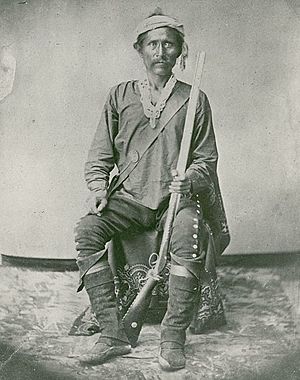Barboncito facts for kids
Barboncito (born around 1820, died 1871) was an important Navajo leader. His Navajo name was Hastiin Dághaaʼ. He was known for his wisdom and for helping his people.
Contents
Who Was Barboncito?
Barboncito's Spanish name means "little bearded one." He was also called Hástiin Dághá, which means "Man with the Whiskers." Other names for him were Bistłahałání ("The Orator") and Hózhǫ́ǫ́jí Naatʼááh ("Blessing Speaker").
He was born in 1820 at Cañon de Chelly in what is now Arizona. Barboncito belonged to the Ma'íí deeshgíízhiníí, or "Coyote Pass People" clan. He was also the brother of another Navajo leader named Delgadito.
Barboncito's Role as a Leader
Barboncito was a key figure in many agreements between the United States government and the Navajo people.
Early Treaties and Conflicts
In 1846, he signed the Doniphan Treaty, also known as the Bear Springs Treaty. This treaty tried to bring peace between the Navajo and Americans during the Mexican War. However, not all Navajo leaders signed it, so the peace did not last.
Later, Barboncito worked with another Navajo leader, Manuelito. They tried to stop the forced movement of Navajo people from their lands.
Barboncito was the Head Chief of the Navajo when the Bosque Redondo Treaty was signed in 1868. This treaty was very important. It ended fighting between the U.S. and the Navajo. It also allowed the Navajo to return to their homeland at Cañon de Chelly. This ended the terrible Long Walk of the Navajo, where many Navajo people died.
Barboncito was known as "The Orator" and "Blessing Speaker." He often tried to make peace between the Navajo and white settlers. In the 1850s, he worked as a mediator to prevent bigger wars.
Despite his efforts, problems continued. Navajos and white settlers argued over grazing lands near Fort Defiance in Arizona. The Navajo had used these lands for centuries. But the new settlers also wanted them for their horses.
In 1860, U.S. soldiers killed many Navajo horses. In response, the Navajo raided army herds to get their horses back. This led Barboncito to take action. He led about one thousand men to Fort Defiance. They almost captured the fort, but the U.S. Army pushed them back into the Chuska Mountains. There, the Navajo used hit-and-run attacks against the U.S. forces.
Peace Talks and Forced Relocation
After the fighting, both sides met for peace talks again. Barboncito, Manuelito, Delgadito, and other chiefs met with Colonel Edward R. S. Canby in 1861. They agreed to a new treaty. For a while, the Navajo and white settlers tried to be friends, but distrust remained.
The United States then began a harsh campaign against the Navajo. Colonel Christopher "Kit" Carson led this effort with Ute mercenaries, who were old enemies of the Navajo. Barboncito tried to make peace with General James H. Carleton, Carson's commander, in 1862. But the attacks on the Navajo continued.
Carson destroyed Navajo fields, fruit trees, and hogans (traditional Navajo homes). He also took their cattle. While only 78 of 12,000 Navajo people were killed, Carson's actions broke their spirit. By 1864, he had ruined Cañon de Chelly, cutting down thousands of peach trees and destroying corn fields. With no food or supplies, the Navajo were forced to give up their sacred homeland.
The Long Walk and Return Home
In 1864, Barboncito was captured by Carson's troops in Cañon de Chelly. After seeing the terrible conditions, Barboncito escaped in June 1865 with about 500 followers.
That same year, the "Long Walk" began. About 8,000 Navajo people, two-thirds of the tribe, were forced to walk 300 miles to Bosque Redondo, New Mexico. Almost 200 people died during this journey. The remaining 4,000 Navajo escaped west with Manuelito, who surrendered in 1866. Barboncito was the last Navajo leader to be captured and taken to Bosque Redondo. He found the conditions there even worse than he imagined. He escaped again and returned to Cañon de Chelly, but he was recaptured.
In 1868, Barboncito, Manuelito, and other chiefs traveled to Washington, D.C. They met with General William T. Sherman and Colonel Samuel F. Tappan. Barboncito explained that the Navajo creator had warned them never to go east of the Rio Grande River.
The U.S. government did not want to give all their land back to the Navajo. Sherman offered them three choices: move east to Indian Territory, live in New Mexico under its laws, or return to a smaller part of their original lands. The Navajo chose to return to their homeland.
On June 1, 1868, Barboncito and other Navajo leaders signed the Treaty of Bosque Redondo with the U.S. government. This agreement began with the words: "From this day forward all war between the parties to this agreement shall forever cease." It is believed that Barboncito was buried with a handwritten copy of this important treaty.
Barboncito's Legacy
Barboncito was a very skilled negotiator and a talented ceremonial singer. He died in 1871 at the age of 50 in his home village at Cañon de Chelly. His leadership and wisdom were crucial in helping the Navajo people survive and return to their ancestral lands.
See also
 In Spanish: Barboncito para niños
In Spanish: Barboncito para niños


